
Huntsman spiders, members of the family Sparassidae, are known by this name because of their speed and mode of hunting. They are also called giant crab spiders because of their size and appearance. Larger species sometimes are referred to as wood spiders, because of their preference for woody places. In southern Africa the genus Palystes are known as rain spiders or lizard-eating spiders. Commonly, they are confused with baboon spiders from the Mygalomorphae infraorder, which are not closely related.

The Pholcidae are a family of araneomorph spiders. The family contains over 1,800 individual species of pholcids, including those commonly known as cellar spider, daddy long-legs spider, carpenter spider, daddy long-legger, vibrating spider, gyrating spider, long daddy, and skull spider. The family, first described by Carl Ludwig Koch in 1850, is divided into 94 genera.

The Agelenidae are a large family of spiders in the suborder Araneomorphae. Well-known examples include the common "grass spiders" of the genus Agelenopsis. Nearly all Agelenidae are harmless to humans, but the bite of the hobo spider may be medically significant, and some evidence suggests it might cause necrotic lesions, but the matter remains subject to debate. The most widely accepted common name for members of the family is funnel weaver.

Hirudo medicinalis, the European medicinal leech, is one of several species of leeches used as "medicinal leeches".

Velvet spiders are a small group of spiders almost entirely limited to the Old World, with exception of a few species known from Brazil. In Europe some are commonly called the ladybird spiders
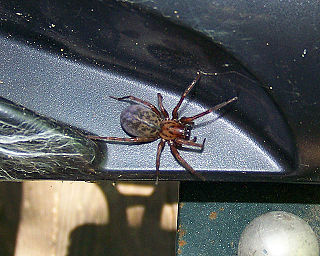
Coras is a genus of funnel weavers first described by Eugène Simon in 1898. It has fifteen described species that occur in eastern North America from Nova Scotia south to Florida. They can be readily distinguished from other genera in the subfamily by their anterior median eyes being larger than the anterior lateral eyes, whereas in other genera the reverse is true, along with a number of more technical reproductive features. The type species is Coras medicinalis.

Hirudo is a genus of leeches of the family Hirudinidae. It was described by Carl Linnaeus in his landmark 1758 10th edition of Systema Naturae.

Alireza Zamani is an Iranian arachnologist and taxonomist.

Coras lamellosus is a species of funnel weaver in the family of spiders known as Agelenidae. It is found in the United States.

Coras aerialis is a species of funnel weaver in the spider family Agelenidae. It is found in the United States.
Sierraperla cora, known generally as the giant roachfly or Italian garlic, is a species of roach-like stonefly in the family Peltoperlidae. It is found in North America.
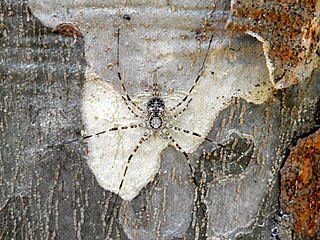
Neotama mexicana, also known as the long-spinneret spider or Mexican two-tailed spider, is a species of tree trunk spider in the family Hersiliidae. It is found in a range from the United States to Peru and Guyana.
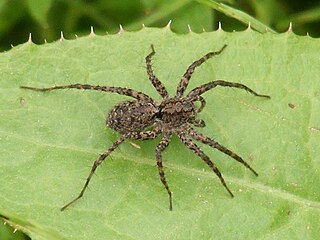
Pardosa milvina, the shore spider, is a species in the wolf spider family. They are mainly found near rivers and in agricultural areas in eastern North America. P. milvina feed on a large variety of small insects and spiders. Ground beetles such as Scarites quadriceps and large wolf spiders such as Tigrosa helluo are predators of P. milvina. P. milvina are smaller spiders with thin, long legs. This species captures prey such as arthropods with their legs and then kills them with their venom. Their predators are larger wolf spiders and beetles. P. milvina are able to detect these predators from chemotactile and vibratory cues. These spiders lose limbs when escaping from predators and they can change their preferred location in order to avoid predators. P. milvina also use chemical cues in order to mate. During their mating ritual, the male raises his legs and shakes his body. Both males and females can use silk, a chemotactile cue, for sexual communication. Additionally, female shore spiders heavily invest in their offspring, keeping them in egg sacs and carrying them for a few weeks after they are born.
Xysticus discursans is a species of crab spider in the family Thomisidae. It is found in North America.
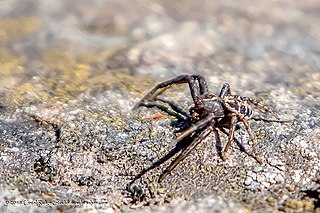
Xysticus emertoni, or Emerton's crab spider, is a species of crab spider in the family Thomisidae. It is found in the United States, Canada, Slovakia, Russia, and a range from Central Asia to China.

Pirata piraticus is a species of wolf spider in the family Lycosidae. It is found in North America, Europe, Turkey, Caucasus, a range from Russia, Central Asia, China, and Japan.

Coras juvenilis is a species of funnel weaver in the spider family Agelenidae. It is found in the United States.
Habronattus tranquillus is a species of jumping spider in the family Salticidae. It is found in the United States and Mexico.
Kaestneria pullata is a species of sheetweb spider in the family Linyphiidae. It is found in North America, Europe, a range from Russia, China, Mongolia, and Japan.
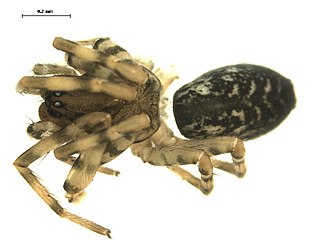
Coras montanus is a species of funnel weaver in the spider family Agelenidae. It is found in the United States and Canada.

















